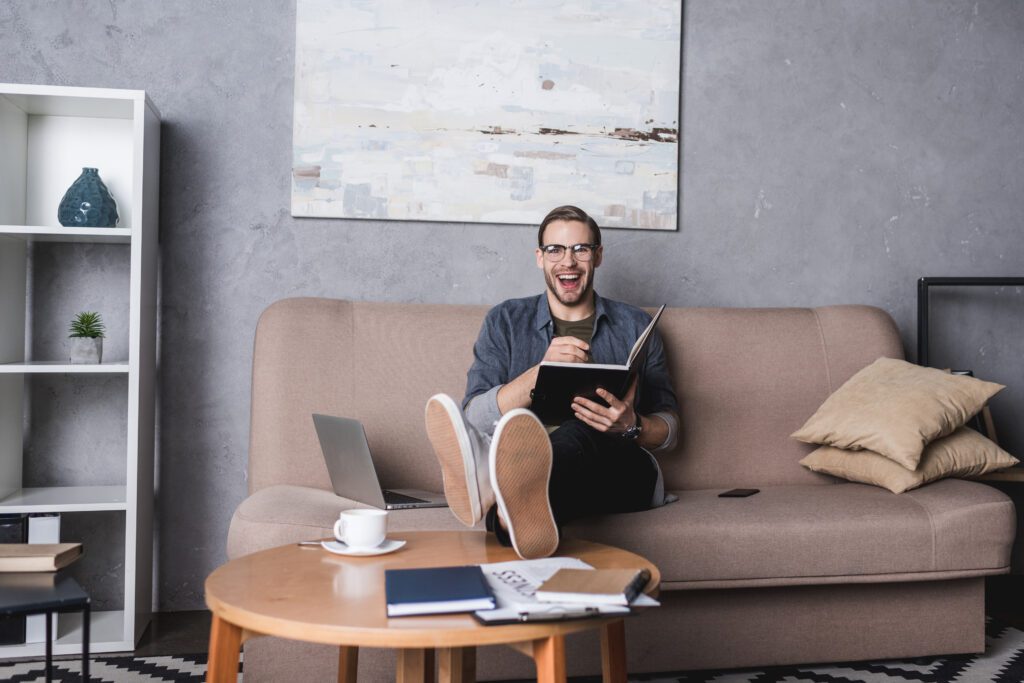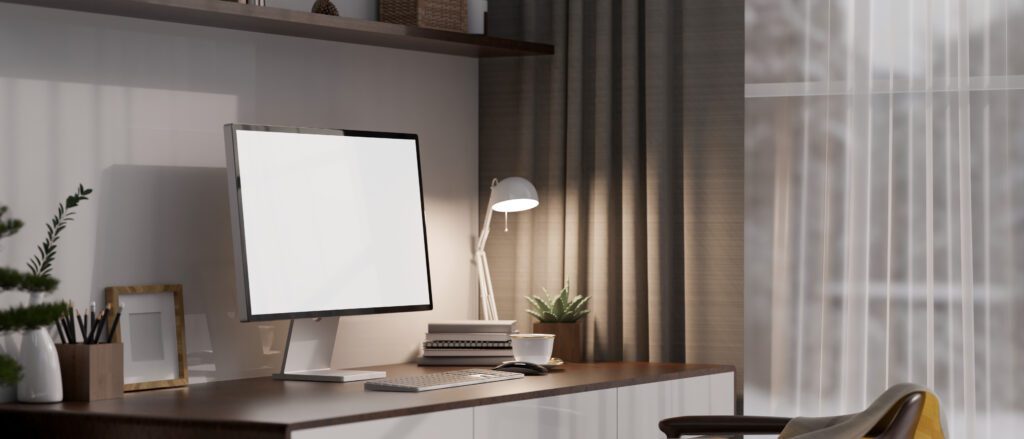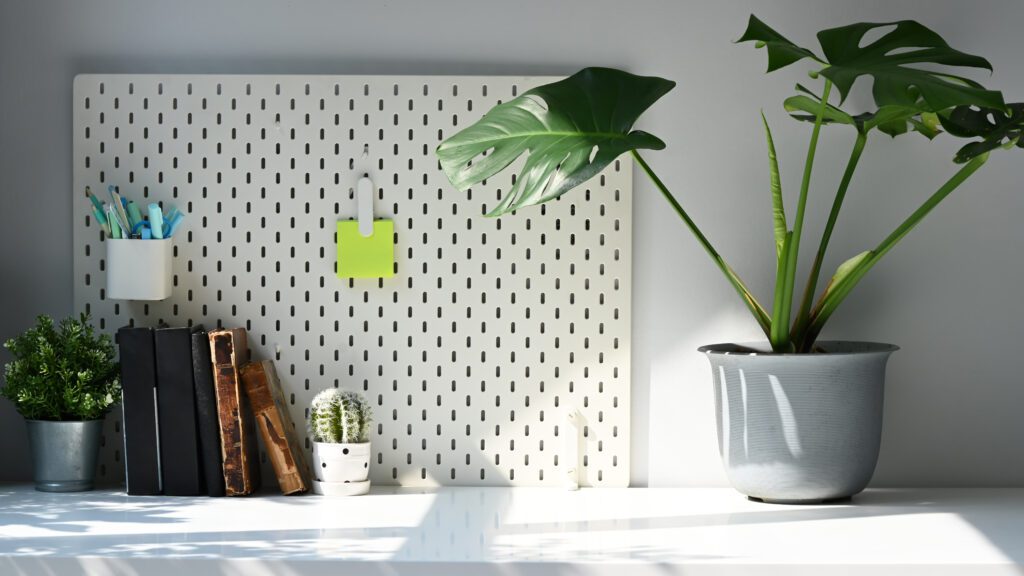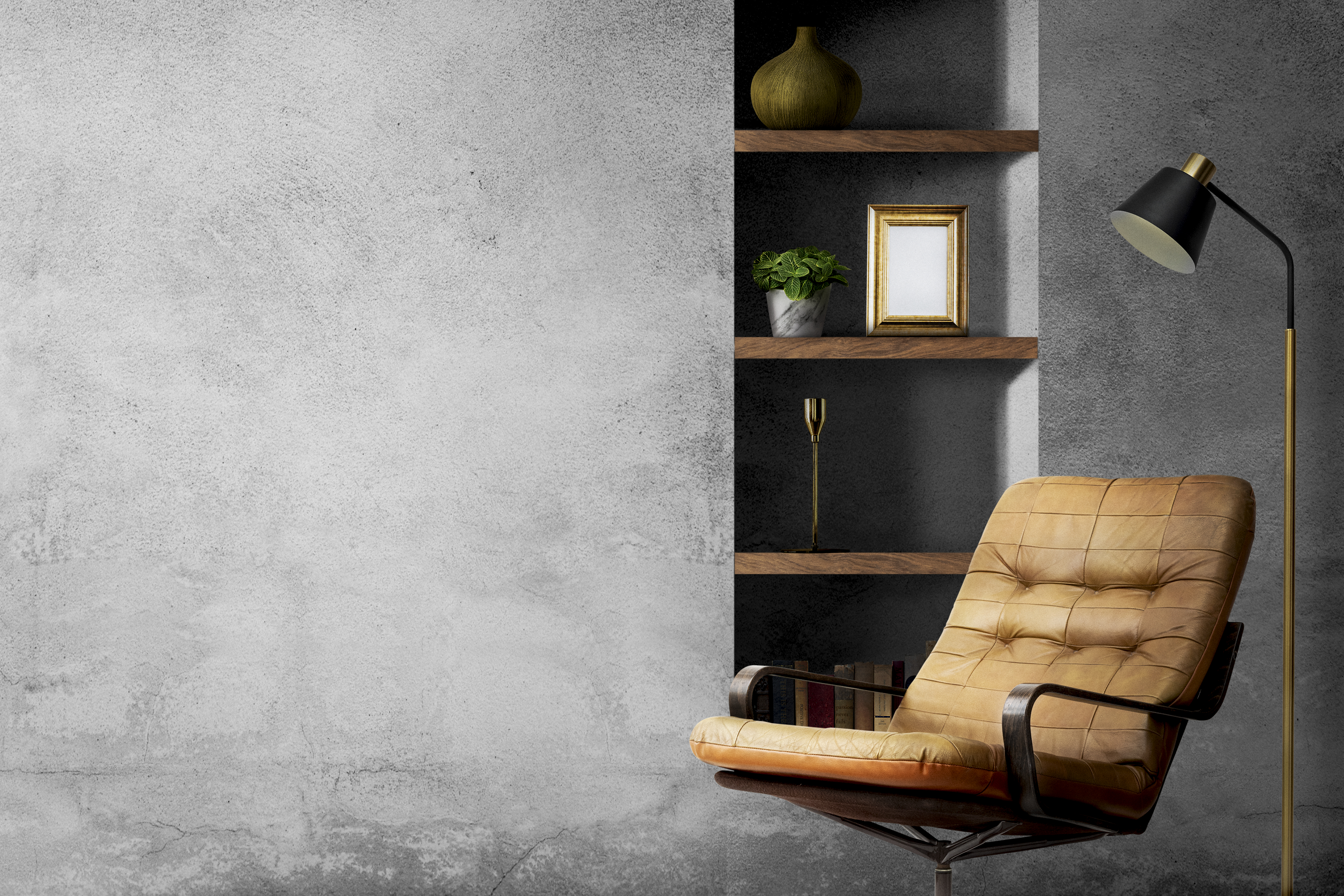Have you ever wondered how you could transform your cramped home office into an environment perfect for a sound sleep? It’s that tiny desk-and-chair setup you’ve got in a corner of your bedroom. But, hold on. Just think about it. What if it could be a place that can help you switch off from work mode and get some quality shuteye? Yes, you heard it right. Despite the limited space, there ARE ways to create a sleep-friendly environment. And no, we’re not talking about installing a hammock right above your laptop (though, we must admit, that’s a tempting idea).
“The key units of a sleep-friendly home office are the right location, organization, and relaxation techniques. It’s like the perfect trifecta.”
Not only that, imagine combatting those late-night cravings for caffeine and alcohol, improving air quality with awesome houseplants, and controlling your room temperature with ease. Sounds too good to be true? Well, I assure you that it’s not a pipedream. It’s attainable, and quite practical, and trust me, you don’t need an Aladdin’s lamp for it. Anyway, you don’t need another genie bossing you around, right?
Table of Contents
So, strap yourself in. This is going to be a fun ride. Let’s dive in, shall we?
Choosing the Right Location for Your Home Office
Okay, let’s dive right in, champ! The location of your home office can play a huge role in determining how well you manage your sleep and overall productivity. Turning that broom closet into a workspace? Not as crazy as it sounds… if it’s quiet, distraction-free, and has just enough room for you and your Dad-bod-personal-space needs.

But here’s the big question: Where in your home should you set up your small but mighty office?
- Far from Noise: Your home isn’t just a home right now. It’s a school, a playground, a daycare, and an office. As much as you love the sound of those delightful squeals and screams, they’re not particularly conducive to focused work, or the peaceful ambiance needed for a good night’s sleep. Aim for a spot away from high-traffic areas.
- Access to Natural Light: Look for spaces with good lighting, preferably natural light. Unless you’re Batman (no judgment here), working in a gloomy space can make you feel like you’re perpetually stuck in the middle of a long winter’s night!
- Good Ventilation: Ever tried to sleep in a stuffy room? Fun as hibernating, right? Proper air circulation is crucial for a good sleep environment and maintaining focus throughout the day. If possible, position yourself close to a window.
Remember, you’re a resourceful, creativity-filled Dad. Small changes can transform even the tiniest corner of your home into a productive workspace. As long as you’ve got a flat surface for your laptop, a comfortable chair, and enough room to wiggle your toes, you’re in business! Literally.
Organizing Your Office for Optimal Efficiency
Alright, now that you’ve settled on the perfect home office spot, let’s dive into the exciting world of organization! This may feel like a chore to some, but promise me it’s worth it. You’ll thank me later—remember, a tidy workspace is a happy workspace. And a happy workspace promotes a good night’s sleep, which is what we’re all about!
A comfortable and well-designed workspace can increase productivity by 20%.
First things first, let’s talk about decluttering. Dealing with a smaller space can be challenging, but it’s an opportunity to get creative. Besides, you don’t want to be tripping over yesterday’s coffee mug or stacks of paper at dark o’clock. So let’s start eliminating the unnecessary items and keep only the key things you need. Pair down on paper use by digitizing documents or use shelving units to keep your office essentials organized without eating up too much space.

Next up is ergonomics—it’s not just a fancy word! The layout of your desk and chair can affect both your efficiency and comfort. Make sure your chair supports your spine and your computer screen is at eye level. An uncomfortable workspace can lead to stress, and we all know that’s not sleep’s best friend!
- Think vertical – Don’t forget to utilize wall space. Shelves, pegboards, or wall-mounted desks can free up considerable space.
- Use of multipurpose furniture – Think foldaway desks, storage ottomans, or desks with built-in shelves.
- Keep it light – Use light colors for your furniture and decor. They reflect more light and make the space feel bigger.
This way, you’re creating not just a conducive environment for work but also a peaceful atmosphere that won’t distract your sleep. Remember, a cluttered room equals a cluttered mind, and we want to avoid that at all costs. And no, that doesn’t mean shoving everything under the bed or in a closet—out of sight, out of mind doesn’t apply here!
Immerse yourself in this organizing spree and reap the benefits of an optimally efficient office. Not only will your work life flourish, but your sleep quality will thank you for it too!
Creating a Dark and Quiet Environment
Creating a dark and quiet environment is like crafting a Halloween night experience, without the spookiness, that’ll send you into dreamland in no time. If you find sleeping in a blinding Broadway-style lit room super easy, I salute you, but for most of us mere mortals, the darker the better.
Finding the Right Window Treatments
Do you have a window in your home office? Treat it right. Window treatments (curtains, blinds, or shades) are not just fashion statements for your window, they’re also sleep-promoting superheroes. Investing in some blackout curtains or blinds can seriously enhance your chances of uninterrupted sleep, by magically transforming day into night. It’s like having a tiny solar eclipse in your room every night!

Keeping the Noise Down
Unless your familiar lullaby is the sound of taxi horns or noisy neighbors, you’re going to want to keep the noise level down. You might not have control over external noise, but you can play white noise or calming sounds that help your brain focus on sleep instead of the dog’s barking match with the squirrels.
Finding the Right Lighting
Before you hit the hay, you should consider the kind of lighting you have in your office. Those bluish LED lights might be great for doing close-up work, but they’re like a triple espresso for the eyeballs when you’re trying to catch some z’s. Substituting them with warm white or yellow light bulbs can make a world of difference. It’s like wrapping your eyeballs in a warm soft blanket, instead of plunging them into iced coffee!
Once you’ve sorted out the noisy, squint-inducing barriers to your sleep, it’s time to march on to the next steps of setting up your home office to be a veritable sleep haven. Next station: temperature control. Don’t worry, we’re not talking nuclear reactor-style controls here.
Incorporating Relaxation Techniques into Your Evening Routine
Alright, dads, let’s get cozy. The work-from-home lifestyle can be pretty intense, and we all know it’s not always easy to switch off at the end of the day. A bit of relaxation before bed can work wonders, not only in helping you fall asleep but also in improving the quality of your sleep once you’re there.
Now, you may be thinking, “I don’t have time for that!” And to that I say, even just five minutes can make a difference. Plus, you’ll thank yourself in the morning. So, ready to have a sleepier, more relaxed you? Let’s dive in.
Breathe Easy
The first relaxation technique we’re going to explore is something you already do all the time: breathing. Mindful breathing exercises can reduce stress and anxiety, and all it requires is a couple of minutes and the willingness to focus. To start, simply close your eyes, breathe in slowly through your nose, and exhale through your mouth. Keep your breaths slow and deliberate, focusing on the sound and the sensation. Before you know it, you’ll be in dreamland.
Stretch It Out
Another great way to relax is to stretch. Not like the kind that ironmen do, but gentle, soothing stretches that help your muscles to relax and let go of tension. Do some neck rolls, shoulder shrugs, and arm circles. You don’t have to turn into Mr. Flexible, but just enough to tell your body, ‘Hey, the workday is over.’
Time for ‘T’ – That’s Temperature, Tunes, and Tea
- Temperature: A cool room around 60 to 67 degrees Fahrenheit is best for sleep. If you don’t have control over your thermostat or if cooling isn’t an option, invest in a fan or wear breathable sleepwear.
- Tunes: Soft, soothing music or nature sounds can also help to relax your mind. Spotify and other music apps have plenty of sleep-friendly playlists you can try.
- Tea: Grandma’s good old “cuppa” can work wonders here. A nice chamomile or peppermint tea can do the trick. Ever heard about melatonin? Just make sure it’s caffeine-free.
Like most good things, it’s going to take some experimenting to figure out what works best for you. But give it a shot, and you’ll be surprised at how a few simple tweaks to your evening routine can transform your workspace into a dreamy sleep-friendly zone.
Avoiding Caffeine and Alcohol Before Bed
Here’s an important tip: limit consumption of caffeine and alcohol before sleep. Both these substances can disrupt your sleep.
Caffeine can affect your sleep for up to 6 to 8 hours after intake. So, taking a coffee break late in the afternoon can interrupt your nighttime sleep.
Caffeine consumption within six hours of bedtime can significantly disrupt sleep patterns.
Although people believe alcohol helps in sleeping, it can result in restless sleep and interruptions in the sleep cycle. You might find yourself waking up at midnight.
Drink water or herbal tea before bed. It may seem dull, but a good night’s sleep gives you extra energy for the next day’s tasks. Avoid late-night caffeine or alcohol for better sleep and productivity.
Incorporating Plants for Your Sleep-Friendly Home Office Air Quality

If you’ve ever spoken to a plant enthusiast, you’ll know they can’t stop raving about the benefits of having greenery in your workspace – and for good reason too. Plants not only add a touch of natural beauty and powerful visual stimuli but they also help improve air quality. Yes, you heard it right! Those lovely little green wonders can help cleanse the air, making your workspace healthier and creating a perfect setup for a good night’s sleep.
So, how do you go about incorporating plants into your home office? Especially when we’re talking about the limited space you might be dealing with.
- Choose the right plants: Some plants are better at purifying air than others. Spider plants, snake plants, and English ivy are great options that require minimal care.
- Consider the size: If you’re strapped for space, go for plants that don’t grow very large. Alternatively, you can opt for hanging plants or small desk plants.
- Pay attention to light requirements: Most plants need ample light to grow, so place them near windows if you can. If your workspace lacks natural light, go for low-light plants like pothos or ZZ plants.
- Check water requirements: Water needs vary greatly from plant to plant. Some need to be watered frequently, while others can survive with less. Understanding your plant’s needs will help it thrive and do its job of cleaning the air.
You don’t need to turn your home office into a botanical garden, but a handful of strategically placed green friends can help create a more inviting space. Moreover, they can help in boosting your productivity during the day, and contribute to a more restful sleep at night.
Taking care of plants can also be a relaxing endeavor – the act of watering, pruning, and tending to your ‘office mates’ can provide a much-needed respite amidst a busy schedule. So, let’s not underestimate the power of a little green therapy!
In the grand scheme of things, your sleep-friendly home office should be a place that promotes relaxation, productivity, and quality rest. Adding a few plants might just be the finishing touch you need to make your workspace a haven for creativity and tranquility! Now, who wouldn’t want that?

Leave a Reply